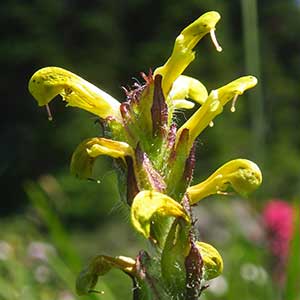Pedicularis rainierensis
Pedicularis semibarbata
Mt. Rainier lousewort
pine woods lousewort, pinewoods pedicularis
basal 2–5, blade lanceolate, 40–80 x 3–20 mm, 2-pinnatifid, margins of adjacent lobes nonoverlapping or slightly overlapping distally, serrate to 2-serrate, surfaces glabrous;
cauline 2–6, blade lanceolate, 15–70 x 5–20 mm, 1- or 2-pinnatifid, margins of adjacent lobes nonoverlapping or slightly overlapping distally, serrate, surfaces glabrous.
basal 3–5, blade lanceolate or spatulate, 20–90 x 5–30 mm, undivided or 1- or 2-pinnatifid, margins of adjacent lobes nonoverlapping or slightly overlapping distally, entire or dentate, surfaces glabrous or tomentose;
cauline 1 or 2, blade lanceolate, 25–80 x 5–10 mm, 1- or 2-pinnatifid, margins of adjacent lobes nonoverlapping or slightly overlapping distally, serrate to dentate, surfaces glabrous or tomentose.
simple, 1–4, exceeding basal leaves, each 10–50-flowered;
bracts lanceolate or subulate to trullate, 10–15 x 1–2 mm, undivided or pinnatifid, proximal margins entire, distal serrate, surfaces glabrous or tomentose.
simple, 1–5, not exceeding basal leaves, each 4–20-flowered;
bracts lanceolate to oblanceolate, 30–90 x 5–40 mm, 1- or 2-pinnatifid nearly to midrib, margins serrate to dentate, surfaces glabrous.
1–3.5 mm.
2–4 mm.
calyx 7.5–11 mm, hispid to tomentose, lobes 5, linear to narrowly triangular, 4–5 mm, apex entire, glabrous or ciliate;
corolla 16–19 mm, tube light or dark yellow, 8–10 mm;
galea light or dark yellow, 8–9 mm, beakless, margins entire medially and distally, apex arching beyond abaxial lip;
abaxial lip light or dark yellow, 4–5 mm.
calyx 7–9 mm, glabrous or tomentose along veins, lobes 5, narrowly triangular, 1.5–5 mm, apex entire, glabrous or ciliate;
corolla 12–25 mm, tube light green or pale yellow, sometimes cream, 7–13 mm;
galea concolored, light green or pale yellow, sometimes cream, 5–12 mm, beakless, margins entire medially and distally, apex nearly straight to arching slightly over abaxial lip;
abaxial lip yellow, sometimes cream, 4–7 mm.
= 16.
Pedicularis rainierensis
Pedicularis semibarbata
Pedicularis rainierensis is known from Mt. Rainier and the Crystal Mountain area. The species is easily confused with P. bracteosa var. latifolia, which often occurs in the same meadows. While the sizes and shapes of their flowers are nearly indistinguishable, P. rainierensis is a much smaller plant with leaves only about three fourths the size, proximal leaf lobes less than one fifth the size, inflorescences about one half the length, and the number of flowers greatly reduced in comparison to those of P. bracteosa var. latifolia.
(Discussion copyrighted by Flora of North America; reprinted with permission.)
Subspecies 2 (2 in the flora).
The basal and cauline leaves of Pedicularis semibarbata are distinctly one- or two-pinnatifid into deep pinnae and narrow subpinnae with serrate margins. The leaves and bracts far exceed the length of the inflorescence, often concealing it. Obvious spatulate, tan-colored, undivided, and membranous leaves are proximal to the divided basal leaves, but they are not as conspicuous as those of P. centranthera, a species with a similar growth form. Proximal floral bracts of P. semibarbata are similar to basal and cauline leaves, whereas in some specimens the distal bracts are spatulate and either once-divided or merely serrate at the apex. Surfaces of the corolla tube and sometimes the galea as well are hispid.
Pedicularis semibarbata grows under ponderosa pine, incense cedar, sugar pine, and white fir, primarily in the southern Cascade Range and Sierra Nevada, in the San Bernardino and San Gabriel mountains of California, and the Mount Charleston region of Nevada.
The flowers of Pedicularis semibarbata in Yosemite National Park were pollinated only by Osmia tristella (L. W. Macior 1977).
(Discussion copyrighted by Flora of North America; reprinted with permission.)
1. Corollas 12–20(–22) mm; leaf lobes 6–20 x 3–14 mm; outside of Mount Charleston region, Nevada. | subsp. semibarbata |
1. Corollas 20–25 mm; leaf lobes 3–12 x 1–8 mm; within Mount Charleston region, Nevada. | subsp. charlestonensis |


